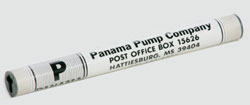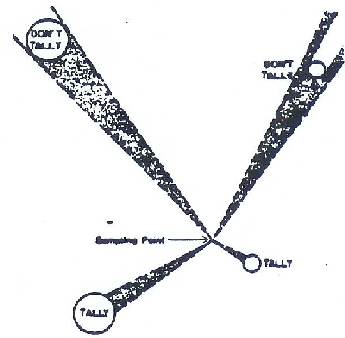|
 The PANAMA Basal Area Angle Gauge is a modification of the 33"
long gauge described in Article by Mr. L.R. Grosenbaugh, Journal of Forestry
Vol. 50, No. 1, Jan. 1952. In reducing the length, we have tried to make
it more convenient to carry --- and use. The PANAMA Basal Area Angle Gauge is a modification of the 33"
long gauge described in Article by Mr. L.R. Grosenbaugh, Journal of Forestry
Vol. 50, No. 1, Jan. 1952. In reducing the length, we have tried to make
it more convenient to carry --- and use.
In the PANAMA Angle Gauge the cruiser looks through the tube
instead of over the top. In reducing the overall length of the gauge we
have maintained the plot radius factor or angle of 104.18 minutes. In the
forward end of the tube we have the two upright lines for paralleling the sides
of the tree. We have opened the parallel lines near the top so that the
cruiser can more quickly come to a decision on borderline trees. We have
also added a slight arch in the exact top center for "centering" the tree.
The widening of the slot at the top for admitting light on either side and the
arch at the top will greatly help in overcoming the objection to a shorter
gauge.

 |
Plotless timber cruising. Shaded area represent 104.18
minute angles optically established by the instrument described above.
Circles represent cross-sections (at breast height) of trees viewed from the
sampling point. Cruiser merely stands at the sampling point (analogous to
a plot center), counts every tree whose d.b.h appears larger than the angle or
aperture, and disregards every tree whose d.b.h appears smaller. All
visible from the sampling point must be counted or rejected. The count of
trees, multiplied by 10, gives an estimate of basal area per acre. In the
diagram, only two trees are counted, so the basal area estimate is 20 square
feet per acre. Reliable estimates require more than one sample, of course.
Basal Area Estimates
Assured of an instrument, the cruiser should decide on the
pattern of sampling points (analogous to plot centers) that he wishes to employ
on the area to be cruised. He must then visit each sampling point (or at
least unbiased point in its vicinity), look in every direction through his
instrument, and them count the number of trees whose d.b.h's appear larger than
the crosspiece of the aperture. The principle is illustrated in figure 1.
The eyepiece (or vertex) of the angle-gauge should pivot on the sampling point
until the count is completed, except that it may be temporarily moved sideways
perpendicular to the line of sight to clear nearby brush or trees likely to mask
other qualifying trees. After a little practice, the cruiser will find he
can gauge all borderline trees by eye alone.
Suppose that the cruiser has tallied a total of 240 qualifying
trees at 30 unbiased sampling points on the area.
|
Estimated Basal area
per acre |
= (10) |
Number of tallied trees |
= (10) |
240 |
= 80 sq. ft |
| Number of sampling points |
30 |
Fixed Type, Weight 2 oz.
|